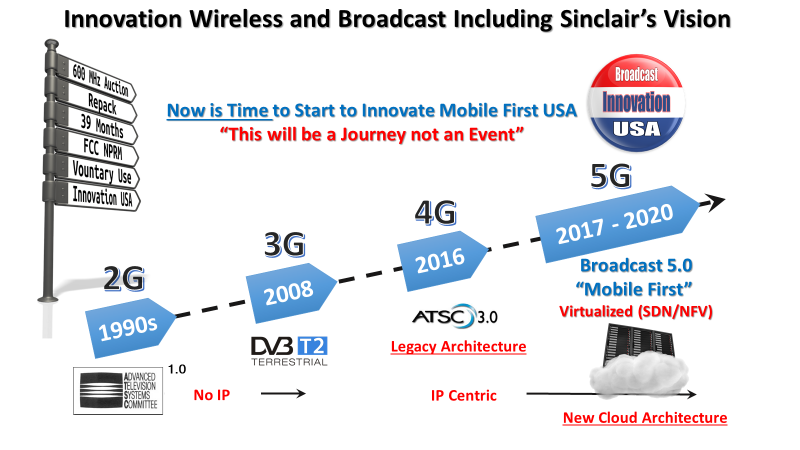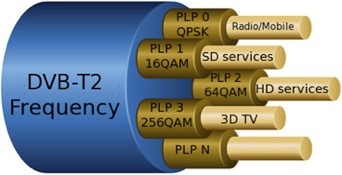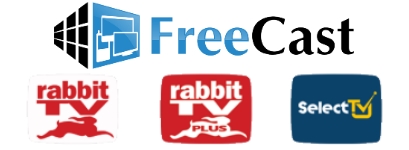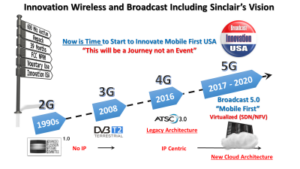Imagine Partners with Sinclair Broadcast to Deliver Content Using ATSC 3.0
Imagine Communications unveiled at the 2017 NAB Show its integrated suite of products positioned to unleash the full power of the emerging ATSC 3.0 specifications. The company demonstrated how the next-generation television standard creates an opportunity for national and regional broadcasters to harness new business and distribution capabilities, including the integration of broadband and broadcast for targeted and personalized content and advertising.
In partnership with SBG, Imagine showed broadcasters a comprehensive ATSC 3.0-optimized solution portfolio, which provides integration across traditional broadcast, over-the-top (OTT) multiscreen delivery and ad management domains. Joint demonstrations and presentations at Imagine’s booth showed how ATSC 3.0-enabled services can expand the business opportunities of broadcasters.
Advertising and programming content monetization options will expand with the adoption of ATSC 3.0, enabling broadcasters to sell and deliver diverse campaigns to targeted audiences and individual consumers. The services being developed by the partnership will provide new ways to originate, distribute, and of course, monetize, content.
 Sinclair sees monetization opportunites from ATSC 3.0
Sinclair sees monetization opportunites from ATSC 3.0
ATSC 3.0 Promises Improved Audience Reach
Speaking at the NAB Show Broadcast Engineering and Information Technology Conference (NAB BEIT), GatesAir TV Systems Applications Engineer Steven Rossiter said that the tremendous number of variables available in the ATSC 3.0 transmission layer can support a wide-ranging variation in coverage scenarios. Consequently, broadcasters can trade off coverage, payload, number of programs (SD, HD and UHD), and effectively provide new mobile and/or hybrid services to suit their own business models.
ATSC 3.0 has the additional capability to provide higher data rates than ATSC 1.0, allowing for the expanded resolutions of UltraHD TV programming, and even 8k Ultra High definition television (8k UHDTV) formats in the future. The tradeoff of this higher data rate is received signal-to-noise ratio: higher data rates mean a smaller coverage area, and vice versa. But ATSC 3.0 already enjoys an advantage over ATSC 1.0, in that both the modulation efficiency (i.e., payload bitrate as a function of channel bandwidth), and the video coding efficiency (bitrate required for a given video quality) are significantly improved.
 The pipes concept is used in DVB-T2. Image:DVB
The pipes concept is used in DVB-T2. Image:DVB
In addition, ATSC 3.0 incorporates “physical layer pipes (PLP),” a concept first realized by the European DVB project. Using PLPs, together with “Layer Division Modulation (LDM),” broadcasters can send services with different data rates and robustness simultaneously, enabling both fixed and mobile services, e.g., from the same transmitter. (In a related talk on coverage, Communications Research Centre Principal Research Scientist Yiyan Wu, said that ATSC 3.0 can enjoy a “significantly high spectrum re-use efficiency, similar to that of LTE.”)
FreeCast Highlights ATSC 3.0 Opportunity
FreeCast plans to deliver a competitive pay-TV experience over-the-air using the new ATSC 3.0 standard, giving customers the opportunity to have à la carte premium channels. The online video firm says that, to date, consumers have been forced to choose between a few dozen channels of over-the-air reception with an HDTV antenna, or hundreds of cable networks via costly cable and satellite subscriptions. But now, the new ATSC 3.0 standard opens up the opportunity to launch hundreds of networks, including pay channels, over-the-air.

FreeCast’s soon to be launched ONE set-top box (STB) product is hoped to play a key role in this offering, adding elements of the current pay-TV experience to a next generation broadcast line-up. It will offer an interactive programming guide for this over-the-air content, and a platform for over-the-top (OTT) content including films, TV shows, Web channels, live events, radio stations and music videos. (FreeCast to offer OTA TV via its ATSC 3.0 STB)
Opera TV Portends the “Future of TV”
 Speaking at the NAB BEIT, Aneesh Rajaram, CEO, Opera TV, painted a positive portrait of the new business opportunities available to broadcasters using ATSC 3.0. “ATSC sets the stage for major changes in the way we can deliver content to our consumers, and the ways they can choose to consume it,” he said.
Speaking at the NAB BEIT, Aneesh Rajaram, CEO, Opera TV, painted a positive portrait of the new business opportunities available to broadcasters using ATSC 3.0. “ATSC sets the stage for major changes in the way we can deliver content to our consumers, and the ways they can choose to consume it,” he said.
According to Rajaram, the new standard will enable broadcasters to deliver “new and dramatically improved services without requiring consumers to upgrade their current TV setup.” The new features that will enable those services include a unified platform, personalized content, HTML5 applications, higher bandwidth, and the marriage of linear and over-the-top (OTT) content.
Opera products enable more than 350 million internet consumers to discover and connect with content and services on multiple devices, independent of network or location. Opera delivers these products and services to more than 120 operators around the world. –agc
OTT Comes to ATSC 3.0
At the NAB Show, Chet Dagit, managing director of RTR Holdings—Lokita Solutions, John Lawson, executive director of the Awarn Alliance, and T.R. Stoner, VP of distribution technology strategy at Univision, discussed ATSC 3.0’s enablement of OTT and OTA second-screen apps.
ATSC 3.0 will allow service providers to deliver “hyper-local content apps that unite FM radio, TV broadcast and on-demand clips into themed content experiences,” according to Dagit. Because ATSC 3.0 uses Internet Protocol (IP) to transfer data packets over-the-air, it is essentially “OTA Internet,” and thus can transform the way users seek and acquire content.
“Imagine an over-the-air version of AppleTV or GoogleTV for a national consumer audience,” they say, “or imagine a business news network tailored to healthcare professionals,” or a “major league sports network where fan-based engagement is based on the location and preferences of each fan.”
These and other services can now be made available, without network congestion, and at a high bandwidth, by using ATSC 3.0. — agc

